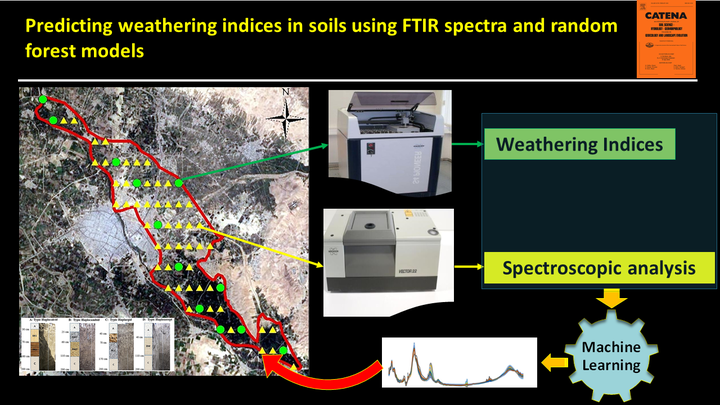Soil Spectroscopy
Predicting weathering indices in soils using FTIR spectra and random forest models

Table of Contents
Video Abstract
Motivation
Although there are some examples relating FTIR spectra and WI through PLSR, the potential use of RF to estimate the variability of soil weathering indices from a limited number of samples has not been investigated. Thus, the main goal of this paper was to evaluate the intensity of weathering and alteration of soils in the Miandoab county, West Azerbaijan, Iran, using different weathering indices and to examine the suitability of FTIR spectroscopy and RF model for predicting different weathering indices as a rapid and inexpensive technique.
Study area
The study area is situated in Miandoab county, West Azerbaijan Province, Iran, and covers approximately 5000 ha

Spectral model development for weathering indices
A chemometric model was applied to detect relations between the weathering indices and FTIR spectra, and to recognize the most relevant spectral bands for this purpose. The process consisted on fitting a RF model with weathering indices as dependent variables and spectral data as predictors.
Weathering indices
All twelve profiles were quite similar in terms of weathering despite the fact that they belong to different soil groups. The CIA and CIW indices had the same pattern, and resembled closely each other in all profiles.

FTIR spectra
FTIR spectra are good predictors of soil composition, since both inorganic and organic soil components have a distinctive signature in the MIR region of the spectra.

Modeling weathering indices using FTIR data
Transmission MIR spectra of the soil samples were used as predictors of the weathering indices using RF models. Result indicates the prediction accuracy of the RF models on calibration and validation data for all the indices. From the results obtained with the validation set, it can be observed that not all the models had the same performance.

In addition to the capability to predict the weathering indices using spectral data, the RF models identified the most important spectral bands for the estimation of each weathering index.

Conclusion
The main goal of this study was to analyze the weathering conditions of the most representative soils of West Azerbaijan, Northern Iran, using chemical indices, and to demonstrate the suitability of FTIR spectra and RF to predict these weathering indices and to identify the major soil components related to soil weathering. The results showed that the soils in the study area are at an early stage of development and fairly homogeneous in terms of weathering. From all the indices, CIA, CIW, MIA and V were the most suitable to evaluate the weathering intensity, and the combination of FTIR spectra and RF models allowed their prediction with high accuracy. In addition to the predictions, the RF models provided valuable information on the most important weathering processes these indices were describing, which are related to the alteration of K-bearing minerals and the relative increase of smectites in these soils.